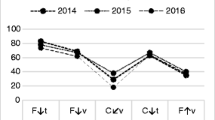Abstract
In this work we analyzed how electric and magnetic lines of force were conceived byFaraday and how they are understood by a group of Argentine university studentsafter receiving instruction. Our results show that many students possess ideas similarto those of Faraday in that lines of force are conceived as real physical entities responsible for the transmission of the electric action. These results are in accordance with the interpretation of physical entities as ``matter-based'' suggested by Chi et al. (1994). It is suggested that emphasis on the geometrical character of these lines seems imperative in basic electromagnetism classes in order to avoid this kind of confusion.
Similar content being viewed by others
References
Alonso, M. & Finn, E.: 1967, Física (Vol. 2) (C. Hernandez & V. Latorre, trans.), Fondo Educativo Interamericano, Mexico.
Bar, V. & Zinn, B.: 1998, 'Similar Frameworks of Action-at-a-distance: Early Scientists and Pupils Ideas' Science & Education 7(5), 471-491.
Chi, M. T. H.: 1992, 'Conceptual Change Within and Across Ontological Categories: Examples From Learning and Discovery in Science' in R. Giere (ed.), Minnesota Studies in the Philosophy of Science,Vol. XV, 129-186, University of Minnesota Press, Minneapolis.
Chi, M. T. H. & Slotta, J. D.: 1993, 'The Ontological Coherence of Intuitive Physics' Cognition and Instruction 10(2–3), 249-260.
Chi, M. T. H., Slotta, J. D. & de Leeuw, N.: 1994, 'FromThings to Processes: A Theory of Conceptual Change for Learning Science Concepts' Learning and Instruction 4, 27-43.
Eylon, B. & Ganiel, U.: 1990, 'Macro-Micro Relationships: the Missing Link Between Electrostatics and Electrodynamics in Student's Reasoning' International Journal of Science Education 12(1), 79-94.
Faraday, M.: 1831/1955, 'Experimental Researches in Electricity' in Maynard Hutchings (ed.), Great Books of the Western World, Encyclopedia Britannica Inc., London.
Faraday, M.: 1852/1955, 'Experimental Researches in Electricity' in Maynard Hutchings (ed.), Great Books of the Western World, Encyclopedia Britannica Inc., London.
Faraday, M.: 1851/1955, 'Experimental Researches in Electricity' in Maynard Hutchings (ed.), Great Books of the Western World, Encyclopedia Britannica Inc., London.
Ferguson-Hessler, M. & de Jong, T.: 1987, 'On the Quality of Knowledge in the Field of Electricity and Magnetism' American Journal of Physics 55(6), 492-497.
Galili, I.: 1995, 'Mechanics Background Influences Students' Conceptions in Electromagnetism' International Journal of Science Education 17(3), 371-387.
Guth, J.: 1995, 'An In-Depth Study of Two Individual Students' Understanding of Electric and Magnetic Fields'' Research in Science Education 25(4), 479-490.
Halliday, D. & Resnick R.: 1981, Física (Vol. 2) (R. Gomez Gonzalez, trans.), Cia. Editorial Continental, Mexico.
Herrmann, F.: 1991, 'Teaching Magnetostatic: Problems to Avoid' American Journal of Physics 59(5), 447-452.
Hesse, M. B: 1961, Forces and Fields. The Concept of Action at a Distance in the History of Physics, T. Nelson and Son Ltd., London.
Jimenez Gomez, E. & Fernandez Duran, E.: 1998, 'Didactic Problems in the Concept of Electric Potential Difference and an Analysis of its Philogenesis' Science amp; Education 7(2), 129-141.
Keil, F. C.: 1979, Semantic and Conceptual Development, Harvard University Press, Cambridge.
McCloskey, M.: 1983, 'Intuitive Physics' Scientific American 248(4), 122-130. ]
McMillan, C. & Swadener, M.: 1991, 'Novice Use of Qualitative Versus Quantitative Problem Solving in Electrostatics' Journal of Research in Science Teaching 28(8), 661-670.
Reiner, M., Slotta, J. D., Chi, M. T. H. & Resnick, L. B.: 2000, 'Naive Physics Reasoning: A Commitment to Substance–Based Conceptions' Cognition and Instruction 18(1), 1-34.
Sequeira, M. & Leite, L.: 1991, 'Alternative Conceptions and History of Science in Physics Teacher Education' Science Education 75(1), 45-56.
Siegel, D. M.: 1991, Innovation in Maxwell's Electromagnetic Theory, Cambridge University Press, Cambridge.
Slotta, J. D. & Chi, M. T. H.: 1999, 'Overcoming Robust Misconceptions Through Ontology Training' Manuscript submitted for publication.
Slotta, J. D., Chi, M. T. H. & Joram, F.: 1995, 'Assessing Students' Misclassifications of Physics Concepts: An Ontological Basis for Conceptual Change' Cognition and Instruction 13(3), 373-400.
Tipler P. A.: 1991, Física (3rd ed.), (J. Aguilar Pens & J. Pacheco Rubia, trans.), Ed. Reverte, Buenos Aires.
Tornkvist, S., Pettersson, K. & Transtromer, G.: 1993, 'Confusion by Representation: On Student's Comprehension of the Electric Field Concept' American Journal of Physics 61(4), 335-338.
Wandersee, J.: 1985, 'Can History of Science Help Science Educators Anticipate Students' Misconceptions?' Journal of Research in Science Teaching 23(7), 581-597.
Whittaker, E.: 1973, A History of Aether and Electricity (Vols. 1–2) (4th ed.), Humanities Press Inc., USA.
Williams, P.: 1965, Michael Faraday. A Biography, Chapman and Hall, London.
Author information
Authors and Affiliations
Rights and permissions
About this article
Cite this article
Pocovi, M.C., Finley, F. Lines of Force: Faraday's and Students' Views. Science & Education 11, 459–474 (2002). https://doi.org/10.1023/A:1016579722962
Issue Date:
DOI: https://doi.org/10.1023/A:1016579722962




